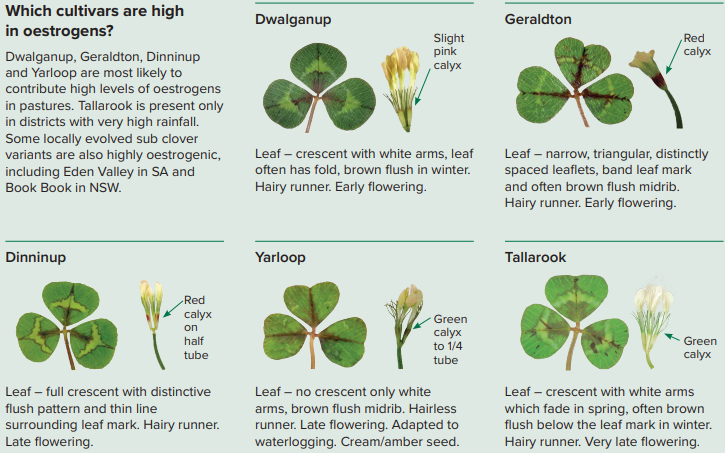Oestrogenic clovers
13 Apr 2021
Oestrogenic clovers have been known to cause fertility issues in ewes across Australia since the 1970’s. Usually found in old clover cultivars, and when the plant material is green, isoflavones act similar to that of natural estrogens. These isoflavones are responsible for a variety of symptoms in sheep including lowered ewe fertility, increased difficult births, prolapse of the uterus, udder development in maiden ewes and wethers and urethral blockages in wethers. As the plant senesces or ‘dies off’ the isoflavones break down and the plant material is safe. Hay and silage cut from paddocks containing high levels of oestrogenic clover can be problematic, particularly if it has been cut and cured at the ideal time, and the plant material has kept its colour (Bennett et al. 2019).
Types of oestrogenic infertility
Oestrogenic clover can cause two types of infertility: permanent and temporary.
Permanentor also known as ‘clover disease’ is cause by sheep grazing these oestrogenic clovers over a long period of time, approximately 2 years. The reproductive disorders caused by permanent infertility are:
- increased dry ewe percentage
- unexpected low lambing percentage, due to a temporary decline in ewe fertility
- increase in uterine prolapse
- increase in vaginal prolapse
- increase in ewe and lamb mortality at birth
- In severe cases loss of fertility, udder development in maiden ewes and wethers
- Enlarged bulbo-urethral glands and urethral blockages in wethers (MLA 2021).
Meanwhile, temporary infertility occurs when sheep graze oestrogenic clovers just before or at time of mating. These clovers supress the oestrus cycle and can also affect sperm transport. Temporary infertility can be resolved if sheep are removed from the oestrogenic clover after 4 to 6 weeks (Foster 2021).
Which clovers cause reproductive issues?
There are a number of old sub clover cultivars that contain high levels of oestrogenic compounds. They tend to be older cultivars, usually sown from the 1930's to the 1960's.
These high oestrogenic clovers varieties are:
- Dwalganup
- Geraldton
- Dinniup
- Yarloop
- Tallarook - only present in high rainfall areas.

(Source: MLA 2021)
If these cultivars have been identified in your pasture, you will need to assess each paddock to assess the prevalence of the problem clover. Oestrogenic clovers may only be a percentage of your clovers, which will affect the overall risk of your paddock. The safety of your pasture is assessed in percentage of problem (oestrogenic) clover in paddock. It is assessed at three levels:
- Safe = 0 – 20%
- Moderate = 20 – 40%
- Potent = > 40%
These cultivars will become a problem if they contribute 20% or more of your pasture biomass (Foster 2021). There are a number of ways to help manage pastures and livestock, if you have high oestrogenic pastures:
Livestock management
- Manage the type of stock grazing the affected paddock/s:
- don’t graze young ewes or lambs
- limit grazing by wethers to avoid high exposure
- rams are not thought to be affected
- cattle may be affected, but likely to be rare
- Paddocks with less than 20% clover are likely to be safe
- Delay joining ewes until at least six weeks after the clover has senesced and ensure ewes are in condition score 3
- Test pasture hay and silage for oestrogens, and if levels are high avoid feeding to ewes
- Check ram health pre-joining and aim for 3% rams at joining
- Consider culling adult ewes scanned not pregnant as they are likely to be permanently infertile (Bennett et al. 2019)
Pasture management
- The best management is through pasture renovation. This can be done in a number of ways
- Dilute feed containing oestrogenic clover
- Try and reduce the clover seed bank by use of cropping for several years
- If considering sowing clover, choose a well-adapted, recently release low oestrogen variety
- Think about buying certified clover seed if renovating pasture (Bennet et al. 2019; Foster 2021)
Although oestrogenic clover could be a reason for your fertility issues in your ewes, remember to consider other reasons for poor lambing results.
For more information on identification of high oestrogenic clovers please contact your local Ag team member.
Resources
Bennett T, McFarland I, Woodard D & Dohle L (2019) Good clover, Bad clover: MLA final report https://www.mla.com.au/globalassets/mla-corporate/research-and-development/final-reports/2021/l.pds.1706-final-report.pdf
Foster K (2021) Oestrogenic clover fact sheet: MLA https://www.mla.com.au/globalassets/mla-corporate/p.psh.1138_oestrogenic_clovers_factsheet-1.pdf
Oestrogenic clovers – identification and remediation. MLA webinar: https://www.mla.com.au/extension-training-and-tools/productivity-and-profitability-webinars/#pasture1
Warning to watch for oestrogenic subclover
https://www.mla.com.au/news-and-events/industry-news/warning-to-watch-for-oestrogenic-subclover/
Choosing the right subclover
Making good pasture investments
https://www.mla.com.au/news-and-events/industry-news/making-good-pasture-investments/